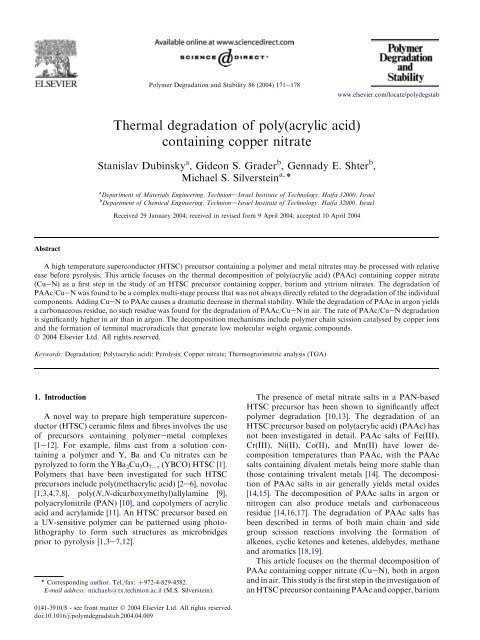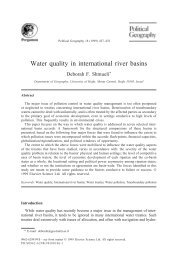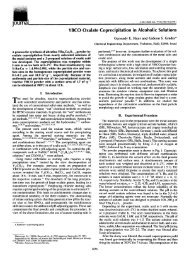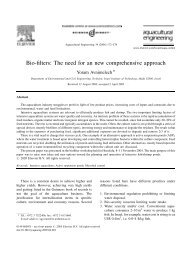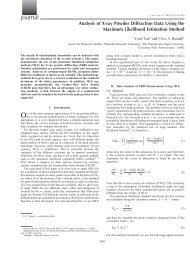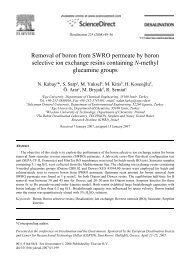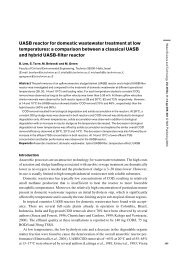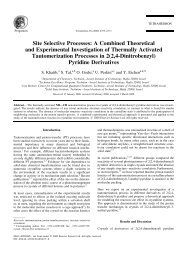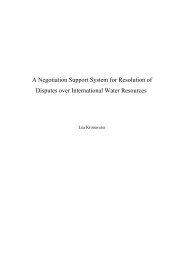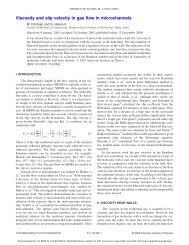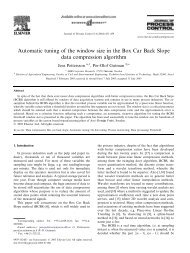Thermal degradation of poly(acrylic acid) containing copper nitrate
Thermal degradation of poly(acrylic acid) containing copper nitrate
Thermal degradation of poly(acrylic acid) containing copper nitrate
You also want an ePaper? Increase the reach of your titles
YUMPU automatically turns print PDFs into web optimized ePapers that Google loves.
Polymer Degradation and Stability 86 (2004) 171e178<br />
www.elsevier.com/locate/<strong>poly</strong>degstab<br />
<strong>Thermal</strong> <strong>degradation</strong> <strong>of</strong> <strong>poly</strong>(<strong>acrylic</strong> <strong>acid</strong>)<br />
<strong>containing</strong> <strong>copper</strong> <strong>nitrate</strong><br />
Stanislav Dubinsky a , Gideon S. Grader b , Gennady E. Shter b ,<br />
Michael S. Silverstein a, )<br />
a Department <strong>of</strong> Materials Engineering, TechniondIsrael Institute <strong>of</strong> Technology, Haifa 32000, Israel<br />
b Department <strong>of</strong> Chemical Engineering, TechniondIsrael Institute <strong>of</strong> Technology, Haifa 32000, Israel<br />
Received 29 January 2004; received in revised form 9 April 2004; accepted 10 April 2004<br />
Abstract<br />
A high temperature superconductor (HTSC) precursor <strong>containing</strong> a <strong>poly</strong>mer and metal <strong>nitrate</strong>s may be processed with relative<br />
ease before pyrolysis. This article focuses on the thermal decomposition <strong>of</strong> <strong>poly</strong>(<strong>acrylic</strong> <strong>acid</strong>) (PAAc) <strong>containing</strong> <strong>copper</strong> <strong>nitrate</strong><br />
(CueN) as a first step in the study <strong>of</strong> an HTSC precursor <strong>containing</strong> <strong>copper</strong>, barium and yttrium <strong>nitrate</strong>s. The <strong>degradation</strong> <strong>of</strong><br />
PAAc/CueN was found to be a complex multi-stage process that was not always directly related to the <strong>degradation</strong> <strong>of</strong> the individual<br />
components. Adding CueN to PAAc causes a dramatic decrease in thermal stability. While the <strong>degradation</strong> <strong>of</strong> PAAc in argon yields<br />
a carbonaceous residue, no such residue was found for the <strong>degradation</strong> <strong>of</strong> PAAc/CueN in air. The rate <strong>of</strong> PAAc/CueN <strong>degradation</strong><br />
is significantly higher in air than in argon. The decomposition mechanisms include <strong>poly</strong>mer chain scission catalysed by <strong>copper</strong> ions<br />
and the formation <strong>of</strong> terminal macroradicals that generate low molecular weight organic compounds.<br />
Ó 2004 Elsevier Ltd. All rights reserved.<br />
Keywords: Degradation; Poly(<strong>acrylic</strong> <strong>acid</strong>); Pyrolysis; Copper <strong>nitrate</strong>; Thermogravimetric analysis (TGA)<br />
1. Introduction<br />
A novel way to prepare high temperature superconductor<br />
(HTSC) ceramic films and fibres involves the use<br />
<strong>of</strong> precursors <strong>containing</strong> <strong>poly</strong>meremetal complexes<br />
[1e12]. For example, films cast from a solution <strong>containing</strong><br />
a <strong>poly</strong>mer and Y, Ba and Cu <strong>nitrate</strong>s can be<br />
pyrolyzed to form the YBa 2 Cu 3 O 7ÿx (YBCO) HTSC [1].<br />
Polymers that have been investigated for such HTSC<br />
precursors include <strong>poly</strong>(meth<strong>acrylic</strong> <strong>acid</strong>) [2e6], novolac<br />
[1,3,4,7,8], <strong>poly</strong>(N,N-dicarboxymethyl)allylamine [9],<br />
<strong>poly</strong>acrylonitrile (PAN) [10], and co<strong>poly</strong>mers <strong>of</strong> <strong>acrylic</strong><br />
<strong>acid</strong> and acrylamide [11]. An HTSC precursor based on<br />
a UV-sensitive <strong>poly</strong>mer can be patterned using photolithography<br />
to form such structures as microbridges<br />
prior to pyrolysis [1,3e7,12].<br />
) Corresponding author. Tel./fax: C972-4-829-4582.<br />
E-mail address: michaels@tx.technion.ac.il (M.S. Silverstein).<br />
The presence <strong>of</strong> metal <strong>nitrate</strong> salts in a PAN-based<br />
HTSC precursor has been shown to significantly affect<br />
<strong>poly</strong>mer <strong>degradation</strong> [10,13]. The <strong>degradation</strong> <strong>of</strong> an<br />
HTSC precursor based on <strong>poly</strong>(<strong>acrylic</strong> <strong>acid</strong>) (PAAc) has<br />
not been investigated in detail. PAAc salts <strong>of</strong> Fe(III),<br />
Cr(III), Ni(II), Co(II), and Mn(II) have lower decomposition<br />
temperatures than PAAc, with the PAAc<br />
salts <strong>containing</strong> divalent metals being more stable than<br />
those <strong>containing</strong> trivalent metals [14]. The decomposition<br />
<strong>of</strong> PAAc salts in air generally yields metal oxides<br />
[14,15]. The decomposition <strong>of</strong> PAAc salts in argon or<br />
nitrogen can also produce metals and carbonaceous<br />
residue [14,16,17]. The <strong>degradation</strong> <strong>of</strong> PAAc salts has<br />
been described in terms <strong>of</strong> both main chain and side<br />
group scission reactions involving the formation <strong>of</strong><br />
alkenes, cyclic ketones and ketenes, aldehydes, methane<br />
and aromatics [18,19].<br />
This article focuses on the thermal decomposition <strong>of</strong><br />
PAAc <strong>containing</strong> <strong>copper</strong> <strong>nitrate</strong> (CueN), both in argon<br />
and in air. This study is the first step in the investigation <strong>of</strong><br />
an HTSC precursor <strong>containing</strong> PAAc and <strong>copper</strong>, barium<br />
0141-3910/$ - see front matter Ó 2004 Elsevier Ltd. All rights reserved.<br />
doi:10.1016/j.<strong>poly</strong>mdegradstab.2004.04.009
172 S. Dubinsky et al. / Polymer Degradation and Stability 86 (2004) 171e178<br />
and yttrium <strong>nitrate</strong>s. The focus on CueN reflects its<br />
ability to dominate the <strong>degradation</strong> process in HTSC<br />
precursors [10,13]. The use <strong>of</strong> both thermal analysis with<br />
simultaneous mass spectroscopy and FTIR analysis can<br />
yield a thorough understanding <strong>of</strong> the <strong>degradation</strong> mechanisms.<br />
Understanding the <strong>degradation</strong> process is an<br />
essential part <strong>of</strong> optimising the pyrolysis conditions for<br />
the production <strong>of</strong> the HTSC phase.<br />
2. Experimental<br />
2.1. Materials<br />
The <strong>poly</strong>mer used was a commercial PAAc with an<br />
average M v <strong>of</strong> about 450,000 (Aldrich Chemical<br />
Company). CueN is <strong>copper</strong> (II) <strong>nitrate</strong> 2.5 hydrate<br />
[Cu(NO 3 ) 2 2.5H 2 O] (Riedel-de Hae¨n). PAAc and CueN<br />
were used as received.<br />
2.2. Sample preparation<br />
The PAAc/CueN films were prepared as follows:<br />
6 wt.% aqueous solutions <strong>of</strong> PAAc were prepared by<br />
stirring and heating in a water bath at 70 (C; CueN was<br />
added to the <strong>poly</strong>mer solutions at different PAAc/CueN<br />
weight ratios: 10/1, 4/1, 2/1 (the materials will be referred<br />
to as ‘10/1’, ‘4/1’ and ‘2/1’); the solutions were cast on<br />
Teflon plates, heated at 60 (C in a circulating air oven for<br />
24 h and then dried at 25 (C in vacuum. Powders were<br />
obtained by grinding the films using a mortar and pestle<br />
and then drying in a vacuum oven at 60 (C for 24 h.<br />
2.3. Characterization<br />
Differential scanning calorimetry (DSC) was carried<br />
out from 25 to 450 (C at5(C/min in either argon or<br />
dry air (4 ml/min) (Mettler DSC-821 calorimeter). The<br />
DSC samples were dry powders (4e6 mg) in an open<br />
aluminium pan and an empty aluminium pan was used<br />
as the reference. The DSC was also used to expose the<br />
materials to high temperatures prior to Fourier transform<br />
infrared spectroscopy (FTIR) characterization.<br />
The samples were heated in the DSC cell to the desired<br />
temperature at 5 (C/min and then quickly cooled to<br />
room temperature. The annealed samples were then<br />
characterized by FTIR to observe the changes in molecular<br />
structure. FTIR spectra from 500 to 4000 cm ÿ1 at<br />
a resolution <strong>of</strong> 2 cm ÿ1 were taken in transmittance using<br />
as-cast films or KBr pellets <strong>containing</strong> 1% <strong>of</strong> the sample<br />
by weight (Bruker Equinox 55).<br />
Simultaneous thermogravimetric analysis (TGA) and<br />
differential thermal analysis (DTA) in situ with TGA<br />
were made from 25 to 1000 (C at5(C/min in either<br />
argon or air using 25 mg samples (Setaram 92-16.18<br />
TGA). The differential thermal gravimetry (DTG)<br />
thermograms were derived from the TGA results using<br />
the supplied s<strong>of</strong>tware. An analysis <strong>of</strong> the pyrolytic exhaust<br />
gases was conducted using an on-line quadrupole<br />
mass-spectrometer (Thermostar 200, Balzers Co.) synchronized<br />
with the TGA/DTA instrument.<br />
3. Results and discussion<br />
3.1. Degradation <strong>of</strong> CueN<br />
The TGA, DTG, DTA and exhaust gas mass<br />
spectroscopy for CueN in argon and in air were<br />
performed to provide reference information. The pyrolysis<br />
<strong>of</strong> CueN included two main stages, dehydration<br />
and denitration, and proceeded much more rapidly in<br />
air. The residual mass <strong>of</strong> about 33.6% corresponded to<br />
the residual mass <strong>of</strong> 34.2% calculated for the pyrolysis<br />
<strong>of</strong> CueN to CuO. The <strong>degradation</strong> <strong>of</strong> CueN and the<br />
formation <strong>of</strong> CuO are described in more detail in the<br />
literature [20e22]. One exceptional observation made<br />
during pyrolysis in Ar (but not during pyrolysis in air)<br />
was the release <strong>of</strong> significant amounts <strong>of</strong> oxygen and <strong>of</strong><br />
a gas with m/z = 44, most likely CO 2 , between 800 and<br />
900 (C. The origin <strong>of</strong> O 2 and CO 2 may lie in traces <strong>of</strong><br />
carbon-<strong>containing</strong> contaminants seen in the FTIR spectrum<br />
<strong>of</strong> CueN [13] which can result in the formation <strong>of</strong><br />
compounds such as carbonates.<br />
3.2. Degradation <strong>of</strong> PAAc<br />
The FTIR spectrum <strong>of</strong> PAAc at room temperature<br />
(Fig. 1a) has a prominent band at 1709 cm ÿ1 associated<br />
with CaO stretching. In addition, there is a very broad<br />
OH stretching band at 3000 cm ÿ1 superimposed on the<br />
CH, CH 2 stretching bands at 3100e2800 cm ÿ1 . There<br />
are distinctive shoulders between 2700 and 2500 cm ÿ1<br />
from overtones and combinations <strong>of</strong> the CeO stretch<br />
band at 1200e1315 cm ÿ1 and from in-plane deformation<br />
<strong>of</strong> CeOeH at 1450e1395 cm ÿ1 . The wide band at<br />
798 cm ÿ1 is associated with an out-<strong>of</strong>-plane OH/O<br />
deformation indicating the existence <strong>of</strong> strong interchain<br />
hydrogen bonds [23]. These band assignments are<br />
summarized in Table 1 and are used for all the PAAc<br />
spectra.<br />
The TGA, DTG, DTA and exhaust gas mass<br />
spectroscopy (MS) for PAAc in argon are found in<br />
Fig. 2. These data are summarized in Table 2, in which<br />
the behaviour <strong>of</strong> PAAc when heated in argon is divided<br />
into three main stages based on the DTA, DTG and MS<br />
peaks. The first stage (70e142 (C) is accompanied by<br />
a 2.5% mass loss, largely associated with the release <strong>of</strong><br />
water (Fig. 2). The carboxyl group band undergoes a<br />
slight shift (from 1709 cm ÿ1 to 1715 cm ÿ1 ), a slight<br />
broadening, and a significant decrease in its intensity<br />
relative to the other bands (Fig. 1b). These changes in
S. Dubinsky et al. / Polymer Degradation and Stability 86 (2004) 171e178<br />
173<br />
152 4<br />
1 4 1 5<br />
310<br />
0<br />
29<br />
6 0<br />
140 2<br />
Absorbance<br />
1 1 50<br />
17<br />
0 9<br />
a<br />
78 9<br />
b<br />
3438<br />
c<br />
d<br />
110 8<br />
1 6 39<br />
1 5 50<br />
1 0 36 136 0<br />
4000 3500 3000 2500 2000 1500 1000 500<br />
Wavenumber, cm -1<br />
Fig. 1. FTIR spectra <strong>of</strong> PAAc after exposure to high temperatures in<br />
argon: (a) as cast; (b) 150 (C; (c) 240 (C; (d) 340 (C.<br />
Fig. 2. <strong>Thermal</strong> analysis and exhaust mass spectra for PAAc in argon.<br />
the carboxyl group indicate that anhydride-like structures<br />
have been formed [24]. Towards the end <strong>of</strong> the first<br />
stage, the PAAc is above its glass transition temperature<br />
(T g )<strong>of</strong>128(C ( from the DSC results). Above the T g the<br />
mobility <strong>of</strong> the PAAc increases and residual <strong>acrylic</strong> <strong>acid</strong><br />
monomer is released (Fig. 2).<br />
The second stage (142e335 (C) is characterized by an<br />
endotherm <strong>of</strong> 0.42 kJ/g at 238 (C and a mass loss <strong>of</strong><br />
27.4% from the release <strong>of</strong> H 2 O, CH 4 and <strong>acrylic</strong> <strong>acid</strong><br />
monomer. The release <strong>of</strong> carbon dioxide (Fig. 2) reflects<br />
the decarboxylation <strong>of</strong> the anhydride structures and the<br />
Table 1<br />
FTIR band assignments for PAAc and PAAc/CueN spectra<br />
Group<br />
PAAc<br />
(cm ÿ1 )<br />
PAAc/CueN<br />
(cm ÿ1 )<br />
OHeO out-<strong>of</strong>-plane deformation 798 e<br />
Ketone 1150 1175<br />
CeO stretch 1200e1315 1169, 1240<br />
NO ÿ 3 stretch e 1385<br />
COH in-plane deformation 1395e1450 e<br />
CaC stretch 1639 1414, 1675<br />
COO ÿ stretch e 1640<br />
COOH stretch 1709 1722<br />
CeOeC (anhydride) stretch 1757, 1810 1740, 1760, 1802<br />
CH, CH 2 stretch 2800e3100 2800e3100<br />
OH stretch 3000 3435<br />
formation <strong>of</strong> intermediate species, which then form<br />
ketenes, ketones and unsaturated compounds [25].<br />
The FTIR spectrum <strong>of</strong> PAAc exposed to 240 (C in<br />
argon (Fig. 1c) is considerably different than that for the<br />
as-cast PAAc. The pronounced carboxylic group band<br />
at 1709 cm ÿ1 in the as-cast material has split into four<br />
sharp peaks in the material exposed to 240 (C. The<br />
peaks at 1810 and 1751 cm ÿ1 are related to glutaric<br />
anhydride [24]. The peak at 1036 cm ÿ1 also indicates the<br />
presence <strong>of</strong> a non-conjugated cyclic anhydride [23]. The<br />
peak at 1705 cm ÿ1 reflects carboxylic <strong>acid</strong> groups in<br />
the chains. The peak at 1639 cm ÿ1 reflects unsaturated<br />
groups [23]. The vinyl CH 2 scissors deformation also<br />
gives rise to a medium intensity band at 1415 cm ÿ1 . The<br />
relative height <strong>of</strong> the band at 1452 cm ÿ1 reflecting<br />
CeOeH in-plane deformation is significantly smaller<br />
Table 2<br />
Summary <strong>of</strong> thermal analysis for PAAc in argon<br />
Stage TGA and DTG DTA peaks<br />
Onset<br />
((C)<br />
DTG peak<br />
((C)<br />
Mass loss<br />
(%)<br />
((C)<br />
DSC heat<br />
(J/g)<br />
1 70 e 2.5 e e<br />
2 142 301 27.4 238, endo 417<br />
3 335 425 55.2 337, endo 40<br />
Total 85.1
174 S. Dubinsky et al. / Polymer Degradation and Stability 86 (2004) 171e178<br />
Fig. 3. <strong>Thermal</strong> analysis and exhaust mass spectra for PAAc in air.<br />
indicating that there has been a considerable reduction<br />
in the amount <strong>of</strong> COH groups during anhydride formation.<br />
The absorption at 1150 cm ÿ1 most likely indicates<br />
the presence <strong>of</strong> cyclic ketones [24]. The peak at<br />
3438 cm ÿ1 is associated with unbound OH groups and<br />
carbonyl group overtones [23].<br />
The third stage <strong>of</strong> PAAc <strong>degradation</strong> in argon ( from<br />
335 (C) is characterized by a mass loss <strong>of</strong> 55.2% which<br />
is largely higher molecular weight species (Fig. 2). These<br />
species, with m/z from 46 to 115, are short chain fragments<br />
created by chain scission [25]. The release <strong>of</strong><br />
<strong>acrylic</strong> <strong>acid</strong> moieties (Fig. 2) represents such a de<strong>poly</strong>merisation<br />
reaction [26]. The residual mass <strong>of</strong> carbonaceous<br />
residue is 14.9%.<br />
The TGA, DTG, DTA and exhaust gas mass<br />
spectroscopy for PAAc in air are found in Fig. 3. These<br />
data are summarized in Table 3, in which the behaviour<br />
Table 3<br />
Summary <strong>of</strong> thermal analysis for PAAc in air<br />
Stage TGA and DTG DTA peaks<br />
Onset<br />
((C)<br />
DTG peak<br />
((C)<br />
Mass loss<br />
(%)<br />
((C)<br />
DSC heat<br />
(J/g)<br />
1 70 100 1.7 e e<br />
2 132 302 27.6 235, endo 393<br />
3 325 420 38.4 exo e<br />
4 448 519 31.1 507, exo e<br />
Total 98.8<br />
<strong>of</strong> PAAc when heated in air is divided into four main<br />
stages based on the DTA, DTG and MS peaks. The first<br />
stage (70e132 (C) is similar to that seen for pyrolysis<br />
in argon: the evaporation <strong>of</strong> physically absorbed water<br />
and the release <strong>of</strong> moieties based on aromatic ions<br />
(m/z = 51, m/z = 78) above the glass transition temperature<br />
<strong>of</strong> 128 (C. In the second stage (132e325 (C),<br />
anhydride formation and decarboxylation become significant<br />
and moieties with m/z = 38 and m/z = 42 are<br />
released. The FTIR band related to unsaturated groups<br />
is more prominent in the PAAc exposed to 240 (C in<br />
argon than in the PAAc exposed to 240 (C in air.<br />
The most significant difference between the thermal<br />
<strong>degradation</strong> in argon and in air is the large exotherm<br />
(DTA) representing <strong>poly</strong>mer combustive oxidation in<br />
air for which there is no corresponding exotherm in<br />
argon. This exothermic oxidation yields a residual mass<br />
<strong>of</strong> 1.2% in air compared to 14.9% in argon. The<br />
exotherm begins during the third stage (325e448 (C)<br />
and is accompanied by the release <strong>of</strong> H 2 O, CO 2 , <strong>acrylic</strong><br />
<strong>acid</strong> from de<strong>poly</strong>merisation, acetone species, species<br />
with m/z = 55 and new species with m/z = 91 and<br />
m/z = 106 from scission in the <strong>poly</strong>mer and in the<br />
anhydride structures. The FTIR spectrum for PAAc<br />
exposed to 340 (C in air is similar to that for PAAc<br />
exposed to 340 (C in argon (Fig. 1). However, the band<br />
at 1810 cm ÿ1 , related to the formation <strong>of</strong> glutaric<br />
anhydride, is seen for exposure in argon but not for<br />
exposure in air. During the fourth stage ( from 448 (C),<br />
only H 2 O and CO 2 are released and the residual mass<br />
reaches 1.2%, indicating complete oxidation.<br />
In summary, the PAAc <strong>degradation</strong> mechanism<br />
includes dehydration, the formation <strong>of</strong> anhydride-type<br />
structures and their decarboxylation, chain scission and<br />
de<strong>poly</strong>merisation. Up to about 340 (C, there is no considerable<br />
difference between the pyrolysis <strong>of</strong> PAAc in<br />
argon or in air. Above 340 (C, pyrolysis in air yields<br />
thermo-oxidation and complete decomposition while<br />
pyrolysis in argon yields a carbonaceous residue.<br />
3.3. Degradation <strong>of</strong> PAAc/CueN<br />
The FTIR spectrum for as-cast 2/1 (Fig. 4a) is<br />
dominated by the band at 1385 cm ÿ1 that is associated<br />
with the <strong>nitrate</strong> ion [23]. The FTIR absorption band at<br />
1640 cm ÿ1 is not seen for neat PAAc. This band is<br />
attributed to COO ÿ stretching (Table 1) and indicates<br />
the formation <strong>of</strong> a complex between the PAAc carboxylic<br />
groups and the <strong>copper</strong> ions. There may be two<br />
metal ion species present: metal ions bound to the<br />
<strong>poly</strong>mer via two carboxylic anions and metal ions coordinated<br />
with H 2 O at one site and bound to a<br />
carboxylic anion at the other [14]. The shift in the<br />
CeO stretching bands, from 1150 and 1240 cm ÿ1 for<br />
PAAc to 1169 and 1247 cm ÿ1 for 2/1, also indicates the<br />
formation <strong>of</strong> a <strong>copper</strong>ecarboxylic complex [27]. In
S. Dubinsky et al. / Polymer Degradation and Stability 86 (2004) 171e178<br />
175<br />
Fig. 4. FTIR spectra <strong>of</strong> 2/1 after exposure to high temperatures. (a) as<br />
cast; (b) 130 (C in argon; (c) 240 (C in argon; (d) 340 (C in argon; (e)<br />
340 (C in air.<br />
addition, the CaO stretching peak has shifted from<br />
1709 cm ÿ1 for PAAc to 1722 cm ÿ1 for 2/1. The presence<br />
<strong>of</strong> this band indicates that not all the carboxylic groups<br />
have formed complexes with <strong>copper</strong> [14,16,28].<br />
The TGA, DTG, DTA and exhaust gas mass<br />
spectroscopy for 2/1 in argon are found in Fig. 5. These<br />
data are summarized in Table 4, in which the behaviour<br />
<strong>of</strong> 2/1 when heated in argon is divided into five main<br />
stages based on the DTA, DTG and MS peaks. As seen<br />
for PAAc, the first stage (70e103 (C) is associated with<br />
the evaporation <strong>of</strong> physically absorbed water. The<br />
second stage (103e216 (C) exhibits a mass loss <strong>of</strong><br />
24%, as water, nitrogen oxides and CO 2 are released<br />
during anhydride formation, anhydride decarboxylation<br />
and <strong>nitrate</strong> decomposition. The endothermic DSC peak<br />
for 2/1 at 158 (C (Fig. 6) represents the melting <strong>of</strong><br />
residual crystallohydrate and <strong>nitrate</strong> decomposition.<br />
The exothermic peak at 180 (C represents the oxidative<br />
<strong>degradation</strong> <strong>of</strong> the <strong>poly</strong>mer catalysed by the <strong>copper</strong> ion<br />
and advanced by the presence <strong>of</strong> nitrogen oxide species.<br />
The sizes <strong>of</strong> the endothermic peak and the exothermic<br />
peak increase with CueN content (Fig. 6) indicating<br />
their origin in the presence <strong>of</strong> CueN. The FTIR<br />
spectrum <strong>of</strong> 2/1 exposed to 130 (C in argon (Fig. 4)<br />
Fig. 5. <strong>Thermal</strong> analysis and exhaust mass spectra for 2/1 in argon.<br />
reveals a decrease in the relative intensity <strong>of</strong> the CaO<br />
band at 1722 cm ÿ1 and a decrease in the relative intensity<br />
<strong>of</strong> the OeH band at 3435 cm ÿ1 . These changes<br />
reflect the evaporation <strong>of</strong> physically absorbed water and<br />
the formation <strong>of</strong> anhydrides.<br />
During the third stage (216e263 (C), water, nitrogen<br />
oxides and CO 2 continue to be released as anhydride<br />
formation, anhydride decarboxylation and <strong>nitrate</strong> decomposition<br />
continue. The FTIR band at 1385 cm ÿ1<br />
representing NO 3 ÿ disappears after exposure to 240 (C,<br />
indicating that the <strong>nitrate</strong> groups have reacted. 2/1<br />
exposed to 240 (C in argon (Fig. 4c) exhibits FTIR<br />
bands associated with glutaric and isobutyric anhydrides<br />
(1802, 1760 and 1740 cm ÿ1 ) [20] as well as the band<br />
Table 4<br />
Summary <strong>of</strong> thermal analysis for 2/1 in argon<br />
Stage TGA and DTG DTA peaks<br />
Onset<br />
((C)<br />
DTG peak<br />
((C)<br />
Mass loss<br />
(%)<br />
((C)<br />
1 70 e 0.4 e e<br />
2a e e e 158, endo e<br />
2b 103 182 24.0 180, exo 71<br />
3 216 243 8.0 247, endo e<br />
4 263 292 12.1 e e<br />
5 331 375 34.2 383, exo e<br />
Total 78.7<br />
DSC heat<br />
(J/g)
176 S. Dubinsky et al. / Polymer Degradation and Stability 86 (2004) 171e178<br />
Exo<br />
Heat Flow, W/gr<br />
d<br />
c<br />
b<br />
a<br />
50 100 150 200 250 300 350 400<br />
Temperature, °C<br />
Fig. 6. DSC thermograms for PAAc/CueN in argon. (a) PAAc; (b) 10/<br />
1; (c) 4/1; (d) 2/1.<br />
Table 5<br />
Summary <strong>of</strong> thermal analysis for 2/1 in air<br />
Stage TGA and DTG DTA peaks<br />
Onset<br />
((C)<br />
DTG peak<br />
((C)<br />
Mass loss<br />
(%)<br />
((C)<br />
1 70 109 12.4 e e<br />
2 143 184 18.4 159, endo 78<br />
3 219 240 5.8 e e<br />
4 250 319 51.8 323, exo 10,000<br />
Total 88.4<br />
DSC heat<br />
(J/g)<br />
associated with carboxylic groups (1708 cm ÿ1 ). The<br />
band at 1045 cm ÿ1 indicates the presence <strong>of</strong> nonconjugated<br />
cyclic anhydrides. The band at 1615 cm ÿ1<br />
and the CH 2 scissors deformation at 1414 cm ÿ1 are<br />
associated with unsaturation [23]. The relative intensity<br />
<strong>of</strong> the band associated with the CeOeH in-plane<br />
deformation at 1450 cm ÿ1 is reduced, indicating a considerable<br />
decrease in carboxylic groups. The absorption<br />
at 1175 cm ÿ1 most likely indicates the formation <strong>of</strong><br />
cyclic ketones from the <strong>degradation</strong> <strong>of</strong> the carboxylic<br />
groups [24].<br />
During the fourth stage (263e331 (C), only water<br />
and CO 2 are released, indicating the end <strong>of</strong> <strong>copper</strong><br />
<strong>nitrate</strong> decomposition. During the fifth stage<br />
(331e550 (C) <strong>acrylic</strong> <strong>acid</strong> and low molecular weight<br />
compounds (m/z = 64, 68, 80e115) are released, indicating<br />
unzipping <strong>of</strong> the <strong>poly</strong>mer chain. The exothermic<br />
peak at about 383 (C in the DSC thermograms<br />
in Fig. 6 represents CuO formation [14,18,19]. Assuming<br />
that PAAc in argon yields a residual mass <strong>of</strong> 14.9% and<br />
that the pyrolysis <strong>of</strong> CueN yields CuO, a residual mass<br />
<strong>of</strong> 21.7% can be predicted. The residual mass <strong>of</strong> 21.3%<br />
at 550 (C is very close to the prediction based on the<br />
pyrolysis <strong>of</strong> the individual components, indicating that<br />
the mechanisms <strong>of</strong> <strong>degradation</strong> for 2/1 in argon are<br />
similar to those <strong>of</strong> the components.<br />
The TGA, DTG, DTA and exhaust gas mass<br />
spectroscopy for 2/1 in air are found in Fig. 7. These<br />
Fig. 7. <strong>Thermal</strong> analysis and exhaust mass spectra for 2/1 in air.<br />
Fig. 8. TGA results for: (a) 2/1 in argon; (b) PAAc in argon; (c) 2/1 in<br />
air; (d) PAAc in air.
S. Dubinsky et al. / Polymer Degradation and Stability 86 (2004) 171e178<br />
177<br />
O O- -O O HO<br />
O O O- -O O HO<br />
Cu 2+ Cu 2+<br />
O<br />
I<br />
II<br />
CH<br />
CH 2<br />
O<br />
O- -O O HO<br />
O<br />
O O- -O O HO<br />
Cu 2+ Cu 2+<br />
Scheme 1. Main chain scission.<br />
O<br />
data are summarized in Table 5, in which the behaviour<br />
<strong>of</strong> 2/1 when heated in air is divided into four main stages<br />
based on the DTA, DTG and MS peaks. The first stage<br />
(70e143 (C) exhibits a relatively high mass loss<br />
(12.4%). The reduction <strong>of</strong> the relative intensity <strong>of</strong> the<br />
carboxyl band at 1718 cm ÿ1 for 2/1 exposed to 130 (C<br />
indicates anhydride formation. The second stage<br />
(143e219 (C) involves decomposition <strong>of</strong> the <strong>nitrate</strong>. In<br />
general, in the first three stages, up to 240 (C, there are<br />
no significant differences between decomposition in<br />
argon and in air.<br />
In the fourth stage (above 250 (C) there is a large<br />
exothermic peak at 323 (C (10 kJ/g) reflecting thermooxidative<br />
<strong>degradation</strong> <strong>of</strong> organic matter. The exotherm<br />
is accompanied by the release <strong>of</strong> water, CO 2 , CO, and<br />
a decrease in the oxygen level that indicates that oxygen<br />
is being rapidly consumed in the pyrolysis. The release<br />
<strong>of</strong> <strong>acrylic</strong> <strong>acid</strong>, indicating unzipping, continues until<br />
380 (C (Fig. 7). After exposure <strong>of</strong> 2/1 to 340 (C in air,<br />
there are barely any traces <strong>of</strong> organic molecules in the<br />
FTIR spectrum (Fig. 4e). Assuming that PAAc in air<br />
decomposes completely and that the pyrolysis <strong>of</strong> CueN<br />
yields CuO, a residual mass <strong>of</strong> 11.7% can be predicted.<br />
The residual mass <strong>of</strong> 11.6% at 380 (C indicates that<br />
these assumptions are correct.<br />
In summary, adding CueN to PAAc dramatically<br />
reduces the thermal stability. The <strong>degradation</strong> temperature<br />
for 2/1 is significantly lower than that <strong>of</strong> PAAc<br />
(Fig. 8). PAAc reaches a constant residual mass at<br />
1000 (C in argon and at 580 (C in air, while 2/1 reaches<br />
a constant residual mass at 550 (C in argon and 380 (C<br />
in air.<br />
These results indicate that the <strong>degradation</strong> mechanism<br />
for PAAc/CueN is similar to the one suggested by<br />
McNeill and Sadeghi [18,19]. Main chain scission leads<br />
to terminal macroradicals (Scheme 1) that can then react<br />
O<br />
O<br />
C<br />
C + CuCO 3 or<br />
O- -O O<br />
O CuO + CO 2<br />
Cu 2+<br />
OR<br />
C<br />
C<br />
CuO +<br />
O- -O O<br />
O O O<br />
Cu 2+<br />
or<br />
CO 2 +<br />
CH CO 2<br />
2 +<br />
C<br />
O<br />
Scheme 2. Formation <strong>of</strong> <strong>copper</strong> carbonate and <strong>copper</strong> oxide.<br />
O
178 S. Dubinsky et al. / Polymer Degradation and Stability 86 (2004) 171e178<br />
by intramolecular transfer to give dimers, trimers and<br />
even <strong>acrylic</strong> <strong>acid</strong>. When backbone scission occurs, it will<br />
almost invariably be followed by side group scission and<br />
yield either a metal carbonate or a metal oxide. This<br />
mechanism also indicates that a number <strong>of</strong> low molecular<br />
weight organic compounds will be formed. Two<br />
intermediate terminal ring structures, formed as a result<br />
<strong>of</strong> side chain scission, may yield <strong>copper</strong> carbonate and<br />
<strong>copper</strong> oxide (Scheme 2).<br />
4. Conclusions<br />
The <strong>degradation</strong> <strong>of</strong> PAAc/CueN is a complex multistage<br />
process that is not always directly related to the<br />
<strong>degradation</strong> <strong>of</strong> the individual components. Adding<br />
CueN to PAAc causes a dramatic decrease in thermal<br />
stability. While the <strong>degradation</strong> <strong>of</strong> PAAc in argon yields<br />
a carbonaceous residue, no such residue was found for<br />
the <strong>degradation</strong> <strong>of</strong> PAAc/CueN in argon. The rate <strong>of</strong><br />
PAAc/CueN <strong>degradation</strong> is significantly higher in air<br />
than in argon. The decomposition mechanisms include<br />
<strong>poly</strong>mer chain scission, catalysed by <strong>copper</strong> ions,<br />
followed by the formation <strong>of</strong> the terminal macroradicals<br />
that generate low molecular weight organic compounds.<br />
Acknowledgements<br />
The authors gratefully acknowledge Dr. Irene von<br />
Lampe with thanks for her most helpful suggestions.<br />
The partial support <strong>of</strong> the German Israel Foundation<br />
and the Pozanski Fund are gratefully acknowledged.<br />
References<br />
[1] von Lampe I, Schultze D, Zygalsky F, Silverstein MS. Polym<br />
Degrad Stab 2003;81:57.<br />
[2] Chien JCW, Gong BM, Madsen JM, Hallock RB. Phys Rev 1988;<br />
38B:11853.<br />
[3] von Lampe I, Bruckner A, Gotze S. Angew Macromol Chem<br />
1997;25:157.<br />
[4] von Lampe I, Schmalstieg A, Gotze S, Muller JP, Zygalsky F,<br />
Lorkowski HJ, et al. J Mater Sci Lett 1997;16:16.<br />
[5] Zygalsky F, von Lampe I, Gotze S. Appl Supercond 1998;<br />
6(10e12):795.<br />
[6] von Lampe I, Schultze D, Zygalsky F. Polym Degrad Stab 2001;<br />
73:87.<br />
[7] von Lampe I, Gotze S, Zygalsky F. J Low Temp Phys 1996;105:<br />
1289.<br />
[8] Lumelsky Y. MSc thesis. Department <strong>of</strong> Materials Engineering,<br />
Technion, Haifa, Israel.<br />
[9] Naka K, Tachiyama V, Ohki A, Maeda S. J Polym Sci Part A<br />
Polym Chem 1996;34:1003.<br />
[10] Silverstein MS, Najary Y, Lumelski Y, von Lampe I, Grader GS,<br />
Shter GE. Polymer 2004;45(3):937.<br />
[11] Pomogailo AD, Savost’ynov VS, Dzardimalieva GI, Dubovitskii<br />
AV, Ponomaryev AN. Izv Akad Nauk Ser Khim 1995;6:1096.<br />
[12] von Lampe I, Zygalsky F, Hinrichsen G. Physica C 2000;341:<br />
2381.<br />
[13] Silverstein MS, Najary Y, Grader GS, Shter GE. J Polym Sci Part<br />
B Polym Phys 2004;42(6):1023.<br />
[14] Skupinska J, Wilczura H, Boniuk H. Pol J Therm Anal 1986;<br />
31(5):1017.<br />
[15] McCluskey PH, Fishman GS, Snyder RL. J Therm Anal 1988;<br />
34:1441.<br />
[16] Allan JR, Bonner JG, Gerrard DL, Birnie J. Thermochim Acta<br />
1991;185(2):295.<br />
[17] Gronowski A, Wojtzak Z. J Therm Anal 1983;26:233.<br />
[18] McNeill IC, Sadeghi SMT. Polym Degrad Stab 1990;30:213.<br />
[19] McNeill IC, Sadeghi SMT. Polym Degrad Stab 1990;30:267.<br />
[20] Cseri T, Bekassy S, Kenessey G, Liptay G, Figueras F.<br />
Thermochim Acta 1996;288(1e2):137.<br />
[21] Jolly WL. The inorganic chemistry <strong>of</strong> nitrogen. New York: W.A.<br />
Benjamin; 1964. p. 69e88.<br />
[22] Zivkovic ZD, Zivkovic DT, Grujicic DB. J Therm Anal Calorim<br />
1998;53(2):617.<br />
[23] Colthup NB, Daly LH. Introduction to infrared and Raman<br />
spectroscopy. 3rd ed. New York: Academic Press; 1990.<br />
[24] McGaugh MC, Kottle S. J Polym Sci Polym Lett Ed 1967;<br />
5(9):817.<br />
[25] McNeill IC, Sadeghi SMT. Polym Degrad Stab 1990;29(2):233.<br />
[26] Grant DH, Grassie N. Polymer 1960;1:125.<br />
[27] Cardenas G, Munoz C, Carbacho H. Eur Polym J 2000;36(6):<br />
1091.<br />
[28] Allan JR, McCloy B, Gardner AR. Thermochim Acta 1993;<br />
214(2):249.


